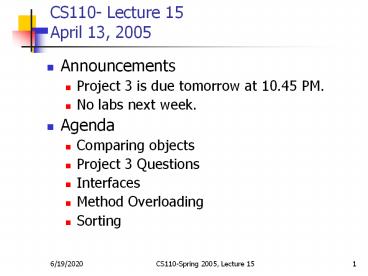CS110- Lecture 15 April 13, 2005 - PowerPoint PPT Presentation
Title:
CS110- Lecture 15 April 13, 2005
Description:
CS110-Spring 2005, Lecture 15. 2. Comparing Strings. public int ... if obj1 is greater than obj2, return ve. if obj2 is greater than obj1, return ve. ... – PowerPoint PPT presentation
Number of Views:15
Avg rating:3.0/5.0
Title: CS110- Lecture 15 April 13, 2005
1
CS110- Lecture 15April 13, 2005
- Announcements
- Project 3 is due tomorrow at 10.45 PM.
- No labs next week.
- Agenda
- Comparing objects
- Project 3 Questions
- Interfaces
- Method Overloading
- Sorting
2
Comparing Strings
- public int compareTo(String s) // not boolean
- hello.compareTo(help!) // -4 (l - p)
- help!.compareTo(hello) // 4 ( p l)
- hello.compareTo(hell) // 1 ( 5 - 4)
- hello.compareTo(hello) // 0
- The idea is
- x.compareTo(y) 0 just when x.equals(y)
- x.compareTo(y) lt 0 when x lt y
- x.compareTo(y) gt 0 when x gt y
- compareTo is wonderful for sorting
(alphabetizing)
3
String compareTo pseudocode
- March through the character arrays looking for
first char difference
(be sure not to run off the end, since
lengths may differ) - if you find a char difference, return it
(numerically) - if no difference when you reach the end of the
shorter string, return the difference in lengths
(0 if the same)
4
Comparing Objects
- The idea is same
- obj1.compareTo(obj2)
- if objects are equal, return 0
- if obj1 is greater than obj2, return ve.
- if obj2 is greater than obj1, return ve.
- But how we decide that when objects are equal,
one object is less than the other or greater than
the other. - We choose our own criteria.
5
Comparing Objects
- For e.g.
- A pixel is greater than other pixel if its
luminance is more - A student is less than the other if his/her
age is less than other student - or
- A student is less than other student if
his/her name comes alphabetically before the
other student.
6
Interfaces
- We have used the term interface to refer to the
set of public methods through which we can
interact with one another. - We now we are going to formalize this concept
using a particular language construct in Java - A java interface is a collection of constants and
abstract methods.
7
Abstract Method
- An abstract method is a method that does not have
an implementation. - There is no body of code defined for an abstract
method. - The header of the method, including its parameter
list, is simply followed by a semicolon. - An abstract method can be preceded by the
reserved word abstract. - An interface cannot be instantiated.
8
Comparable Interface
- public interface Comparable
- public int compareTo(Object o)
- All the methods in interfaces are abstract
and have public visibility by default. - A class implements an interface by providing
method implementations for each of the abstract
methods defined in the interface.
9
Interfaces
- When a class implements an interface
- the class definition becomes
- public class AClass implements AnInterface
- For e.g.
- public class String implements Comparable
- public class Pixel implements Comparable
- public class ImageBase implements ActionListener
10
Comparator Interface
- public interface Comparator
- public int compare(Object o1, Object o2)
- public boolean equals(Object obj)
- Any class that will implement this Interface
should ideally provide implementation for these
method. But sometimes we dont provide
implementation of equals method (use equals of
Object class)
11
Interfaces
- Cannot instantiate an interface
- Cannot do the following
- // cannot instantiate Comparable class
- // since it is not a concrete class
- Comparable c new Comparable()
- However we can do the following
- Comparable c new String()
12
Method Overloading
- Often the method name is sufficient to indicate
which method is being called by a specific
invocation. - But we can use the same method name with
different parameters lists for multiple methods.
This technique is known as method overloading.
13
Method Overloading
- So a method name can be used again as long as the
number of parameters, the type of those
parameters, and/or the order of the types of
parameters are different. - A methods name along with the number, type and
order of its parameters is called the methods
signature.































